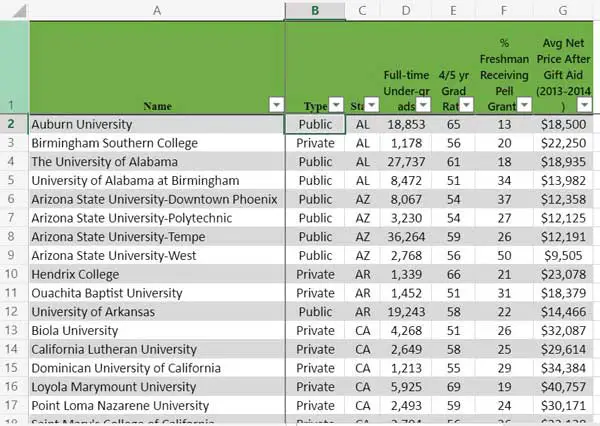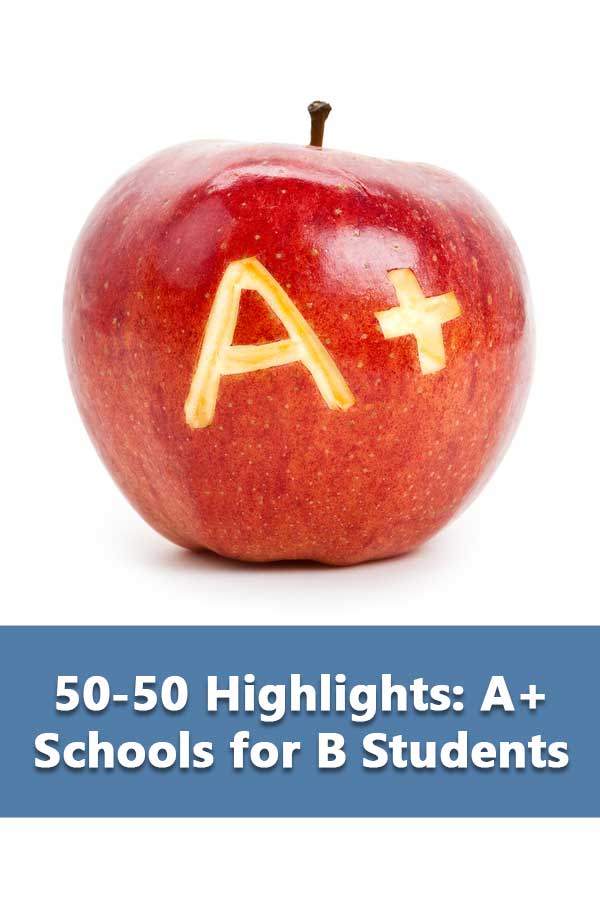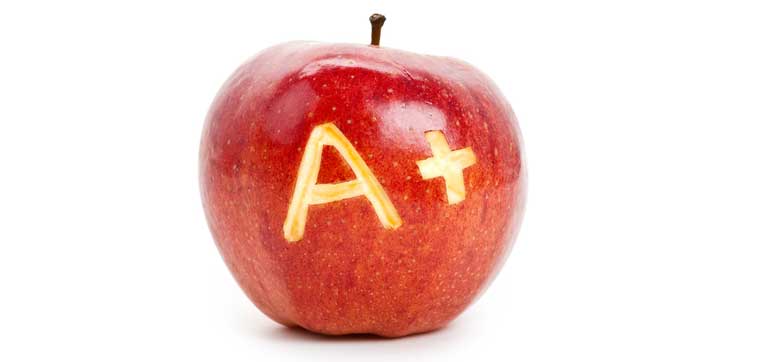 If you want to see everything available in the spreadsheet that I use to create the 50-50 list, check out the sample spreadsheet.
If you want to see everything available in the spreadsheet that I use to create the 50-50 list, check out the sample spreadsheet.
When we hear college rankings, we tend to think of a listing of the “best” colleges, especially since US News College Rankings helps us along with its rankings every fall. Yet, even US News recognizes that not everyone can get into the “best” colleges and these less qualified students are just as deserving of a quality education. So it has created its A+ Schools for B Students list.
According to US News, “These colleges, which have strong ratings in the 2017 U.S. News Best Colleges rankings, accept a significant number of students with nonstratospheric transcripts.” In case you’re wondering, “strong” ratings are defined as being “ranked in the top three-fourths of their 2014 Best Colleges ranking categories.”
That’s right, a strong rating means that you’re in the top three-quarters of your group. It looks like the trophy generation has made it to the college rankings.
What Are A+ Colleges for B Students?
Of course, being a “top-quality” school only makes it eligible for consideration. They also have “to admit a meaningful proportion of non-‘A’ students.” The rankings used the following criteria to identify such schools:
- SAT 75th percentile score less than or equal to 1,350 (based on Critical Reading and Math)
- SAT 25th percentile score greater than or equal to 980 (based on Critical Reading and Math)
- ACT Composite 75th percentile score less than or equal to 30
- ACT Composite 25th percentile score greater than or equal to 20
- Proportion of freshmen from the top 10 percent of their high school class less than or equal to 50 percent (for National Universities and National Liberal Arts Colleges only)
- Proportion of freshmen from the top 25 percent of their high school class less than or equal to 80 percent
- Proportion of freshmen from the top 25 percent of their high school class greater than or equal to 40 percent
- Average freshman retention rate greater than or equal to 75 percent
The sixth and seventh requirements means that at least 40% of students are in the top 25% of their class but no more than 80% can be in the top 25%. However, this is one requirement I can’t use since I don’t have access to class rankings data. And there’s also the fact that an increasing number of schools don’t rank.
A+ Colleges that B Students Can Get Into And Graduate From
Never mind. US News is making the attempt to identify quality schools for the majority of the college going population despite all of the data limitations so I may as well try by applying the same criteria to my list of 50-50 schools.
As I already mentioned, I don’t have class ranking information. I do have test score and retention information. I changed how the test scores are applied. US News uses which test was submitted the most often. I allow for either test to be used as long as at least 20% of freshman submitted scores for the test. So a school might meet the requirements for the ACT test scores but not the SAT as long as at least 20% of freshman submitted ACT scores.
Out of the over 400 50-50 schools, 255 qualified as A+ schools for B students. Forty percent are public schools and 60% are private not-for profit institutions. The schools ranged in size from 580 full-time undergraduates to 42,129. A total of 59 schools had 15,000 or more full-time undergraduates.
The 255 schools can be found in 44 states and the District of Columbia. New York has the most with 24, followed by Indiana, 15, and Ohio, 15. Nine states had only one eligible school.
According to the Carnegie Classification, 57 are Liberal Arts Colleges, 2 are Art or Music schools, and 75 are Research Universities with high or very high research activities. In other words, as long as you aren’t tied to a specific location, you probably have a wide range of schools to choose from.
But Are They Affordable?
Just because these colleges accept B students and graduate at least 50% of them, doesn’t mean these are all affordable schools. There are 58 schools on the list that have an average net price of over $20,000 for students with family incomes of $30,000 or less. Odds are they are not meeting financial need for most students. Only 44 of the colleges had an average net price of less than $10,000 for this income category.
Some of the colleges are great opportunities for merit aid. However, given that 79 of the private colleges have sticker prices over $50,000, you would need significant merit awards to make the cost manageable. As the average net price passes the $30,000 mark, chances are that even with non-need merit aid, the school will still be an expensive one.
The following table lists all 255 schools. As usual, the four-year graduation rate is used for private schools and the five-year rate is used for public schools. You can find a complete listing of 50-50 schools here.
50-50 A+ Colleges for B Student



2 thoughts on “50-50 Highlights: A+ Colleges for B Students”